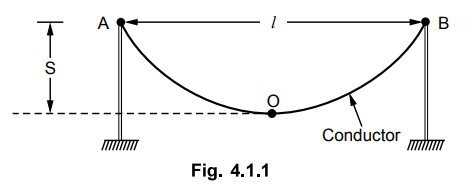Transmission and Distribution: Unit III: (a) Mechanical Design of Transmission Lines
Mechanical Design of Transmission Lines
Introduction
The transmission lines are designed primarily from the economy point of view. To have lowest cost, length of the transmission line must be 7'.
UNIT – III
Chapter - 4
(a) Mechanical Design of Transmission
Lines
Syllabus
Mechanical design of OH lines - Line
Supports - Types of towers - Stress and Sag Calculation - Effects of Wind and
Ice loading.
Contents
4.11ntroduction
4.2 Definition of Sag
4.3 Calculation of Sag and Tension ...
May-04, 11, 13, ... Dec.-10,11,12,13,15,16, Marks
8
4.4 Effect of Atmospheric Conditions on
Transmission Line .... Dec.-04, 05, 07, 10, 13, 14, 15, ... April-01,
May-16,18, ... Marks 13
4.5 Calculation of Diameter for Stranded
Conductor
4.6 Calculation of Sag for Catenary
Shape of Conductor ... Dec.-17, ...
Marks 7
4.7 Tension and Sag at Erection ... May-14, ... Marks 16
4.8 Stringing Chart
4.9 Sag Template and Tower Spotting .... Dec.-17, ... Marks 6
4.10 Vibrations of Conductors and Damper
4.11 Types of Towers ... May-17, ... Marks 5
4.12 Two Marks Questions with Answers
Introduction
It is well known that when a rope is
suspended between the two points then it shows a tendency to sag down. Similarly
when a wire or a conductor is suspended between the two points, the wire sags
down. The wire takes the shape of a catenary or a parabola as shown in the Fig.
4.1.1. This sag plays an important role in the mechanical design of the
overhead transmission lines.

The transmission lines are designed
primarily from the economy point of view. To have lowest cost, length of the
transmission line must be 7' as shown in the Fig. 4.1.1. But due to sag, it
requires more conductor material. Similarly if sag is more, then an extra
height of the supporting poles is also necessary. This increases the cost.
Hence for keeping cost minimum, sag also must be kept minimum.
But if sag is too low then wire gets
subjected to an extra tension. There are some other factors present like
temperature, wind pressure etc., due to which conductor gets subjected to the
maximum stress. If sufficient sag is not kept then conductor cannot sustain
under such tension and there is possibility of the mechanical failure of the
transmission lines.
Thus minimum sag and less tension cannot
be satisfied simultaneously. Hence it is necessary to design the sag value
considering all the severe conditions, such that the tension in the conductor
is always well within the safe limits. Such severe conditions may include the
ice coating on the lines, high wind pressure etc.
Hence it is necessary to study, how to
calculate the sag and the tension in the transmission lines under widely
varying environmental conditions. This chapter explains the sag and tension
calculations in overhead transmission lines which is nothing but the mechanical
design of transmission lines. The chapter also includes the sag template and
vibrational damper used in the transmission line design.
Transmission and Distribution: Unit III: (a) Mechanical Design of Transmission Lines : Tag: : Introduction - Mechanical Design of Transmission Lines
Related Topics
Related Subjects
Transmission and Distribution
EE3401 TD 4th Semester EEE Dept | 2021 Regulation | 4th Semester EEE Dept 2021 Regulation
